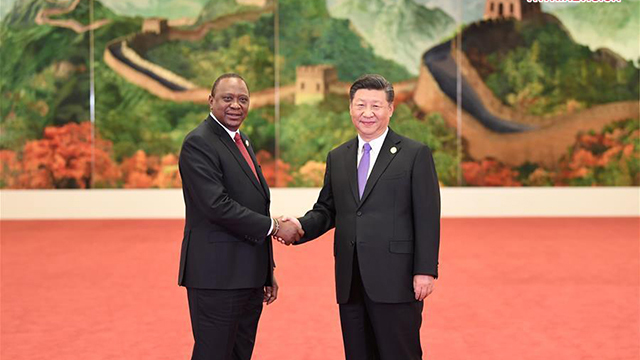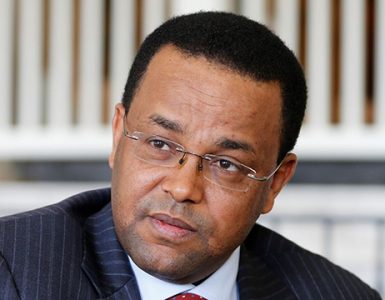China is not only Africa’s leading development partner but also an investor, particularly in infrastructure projects. China has invested in numerous infrastructure projects across the continent. It recognises that there is a huge infrastructure gap that is preventing the development of African countries. As such, it has prioritised infrastructure development in its Africa policy[4]. In Kenya, the Chinese have provided loans and grants for a number of infrastructure projects, including:
- Facilities: Moi International sports centre, Eldoret Hospital upgrades, maize flour processing factory in Bom;
- Transport: Gambogi-Serem road, Kipsigak-Shamakhoko road, Kima-Emusutwi road, Uhuru highway, UNEP road, Nairobi-Thika highway, Nairobi Eastern and Northern by-pass, expansion of the Jomo Kenyatta International Airport, Nairobi-Mombasa Standard Gauge Railway (SGR), Lamu Port, Southern Sudan-Ethiopia Transport Corridor (LAPSSET), Mombasa port terminal and Special Economic Zone, expansion of the Outer Ring Road in Nairobi;
- Energy: Kenya Power distribution system modernisation, Olkaria IV geothermal fields; and
- ICT: Kenya rural telecommunications, Kenya e-government, National Optic Fibre Backbone Infrastructure (NOFBI).[5]
This is further evidence that China is a strategic partner because it is aiding support Kenya’s economic development through infrastructure development. The above demonstrates China’s dominant role in Kenya’s construction sector.
As such, it is reported that the Chinese sponsored infrastructure projects carried out by Chinese workers inhibits skills development in African countries[6]. But under the SGR project, China provided professional skills training to 45,000 local workers to run the SGR effectively[7]. Kenya can leverage on its partnership with China in education to harness skills development. Already, the movement of Kenyans students to pursue their Higher education in China has increased over the years. China has become a preferred destination for higher education for Kenyan students[8]. In this context, the Kenyan government should capitalise on this opportunity to close the skills gap in key sectors and in the process reduce reliance on Chinese labour for future projects. As stated by Ibrahima Diong, “Development in Africa needs to leave something behind so we do not have to depend on China over and over again”[9].
With regards to trade, it is on record that bilateral trade relations are occurring on unequal terms, a fact acknowledged by President Uhuru Kenyatta[10]. Kenya’s total exports to China have increased from an average of USD 51 million from 2011 to 2013, to USD 92 million from 2014 to 2016[11]. Although, this is an indication that Kenyan exports to China have grown, there are concerns over the composition these exports. In terms of structure, export products from Kenya to China comprised crude materials such as hides and skins, scrap metals, sisal; coffee and tea[12]. This pattern of export that is more towards low value-added products is the main reason why Kenya makes somewhat marginal gains from trading with China.

But Kenyan exports to China, also include a small quantity of manufactured goods which presents a window of opportunity for increasing and diversifying its trade with China. Industrial goods from Kenya to China increased from an average of USD 10 million from 2011to 2013 to USD 18 million from 2014 to 2016[13]. In contrast, Kenya exported industrial goods worth approximately. USD 125 million to the European Union (EU) in 2016 alone[14]. Accordingly, these figures show that Kenyan industrial exports to the EU market as compared to the Chinese market are higher. The discrepancy in the value of Kenya’s exports to China and the EU can be partly attributed to the preferential access its products enjoys within the EU market[15]. This means that these products attract less tariffs, a privilege that Kenya does not enjoy when it comes to the Chinese market. It is therefore, possible that Kenya can negotiate a similar type of arrangement with the Chinese government so as to expand the quantity of industrial exports to China.
Despite some incremental increase in Kenya’s exports to China in the recent past, trade between the two countries favours China. Kenya’s trade deficit with China is approximately USD 3.7 billion owing to the import-export ratio [16]. Kenya imports large quantities of varied high value-added products such as machinery, electronic and electrical goods, textile and fertilizer, plastics, furniture, lighting, iron, steel and ceramic products to mention but a few[17]. This situation is not only unique to Kenya but to all African countries operating within the Forum on China-Africa Cooperation (FOCAC) framework. In fact, African leaders have repeatedly raised the issue of the widening trade deficit and called on the Chinese to address this issue in order fully realise a win-win cooperation[18].
Furthermore, the trade deficit with China is also the reason why Kenya rejected the free trade agreement that China has been negotiating with the East African Community (EAC). The Kenyan government’s argument was that the deal would grant Chinese goods more favourable access to the EAC market. But, more importantly, the government was fearful of Chinese imports would flood the domestic market and consequently destroy its manufacturing sector[19]. This risky trade pattern of exporting only primary products and importing manufactured products has the potential of locking the Kenyan economy in the production of primary products and in the process, damage the prospects for industrialisation.
Like in many African countries, China has become the largest provider of Foreign Direct Investment (FDI) in Kenya. Several Chinese companies have come forward to contribute millions of dollars needed to fund the development of several projects such as the industrialization research and development production base, the Nairobi Global Trade Centre, industrial parks and an economic zone[20]. These are a boost for the country’s industrial development, particularly because the Chinese have identified Kenya as the continental industrial hub[21].
While these contributions have the potential to contribute positively to Kenya’s economy, they have come at a high cost. Kenya’s debt to China now stands at approximately USD 5.2 billion and it is likely to increase if the government does not put measures in place to control borrowing[22]. This debt is so high that the World Bank warned it could affect the country’s economic prospects. Nevertheless, the achievements in economic relations over the years have been mixed. On the one hand, the bilateral relations have broadened to diverse fields, trade between the two countries has increased continuously, direct investments from China have more than doubled and Chinese construction enterprises are increasingly involved in large-scale infrastructure projects in Kenya. On the other hand, Kenya faces a growing debt with China, adding to its increasing debt burden and suffers a trade deficit, which if not addressed can be a major obstacle in China-Kenya relations.
In the 55 years of China-Kenya relations, the two countries have developed a strong partnership. The Chinese have and will continue to support development and infrastructure projects that contribute to Kenya’s overall progress. However, the cost associated with these projects is what the government needs to be conscious about. The evidence has shown that Chinese sponsored infrastructure projects have come at a steep cost. Kenya’s mounting indebtedness to China is a cause for concern for the future of the country. As such, it is important that the government assesses the type of FDI assistance it needs from China to pursue the country’s development objectives. From this exercise, the government can then develop policies to attract such type of FDI. Additionally, Kenya should use the educational opportunities offered by China to build its own human resource capacity. This will ensure that there are local skills in different sectors needed to achieve the country’s development goals.
On the trade side the country can curb the trade deficit by shifting from exporting primary goods to value adding products to China. Twenty-first century global trade patterns are determined by a country’s industrial structure and capabilities, therefore to increase its export earnings from China, the government must find ways of strengthening its manufacturing sector to improve its export competitiveness. In sum, Kenya and China need each other but the question of whether China is good or bad for Kenya is dependent on her ability to manage its relations with China. Kenya’s inability to formulate a strategy for engaging China has put the country in the disadvantageous position it finds itself in at present. To have a win-win relationship with China, Kenya must forge a common government strategy that covers the existing and new cooperation areas linked to Kenya’s development goals. This will ensure that the country negotiates from a position of strength and that the agreements made are beneficial to economy and the Kenyan citizenry.
[1] Nyaga, W., Munga, A., Kinyua, L., Gathu K., & Nge’no W. 2017. ‘Kenya China Relations: Portrait of Economic Cooperation in the New Millennium’, International Journal of Social Science and Humanities Research, Vol. 5, Issue 3, pp. 254-269. Available At: http://www.researchpublish.com/ [Last Accessed: 12 September 2018].
[2] Kagwanja, C. 2015. ‘China, Kenya Forging Friendship’, The Star, viewed on 12 September 2018, from https://www.iol.co.za/.
[3] PSCU 2015. Kenya, China Partnership to Focus on Industrialisation, on the Capital FM Website, viewed on 26 July 2018 from: https://www.capitalfm.co.ke/.
[4] Du Plessis, R. 2016. China’s African Infrastructure Projects: A Tool in Reshaping Global Norms, South African Institute of International Affairs: Johannesburg. Available At: http://www.saiia.org.za/ [Last Accessed: 12 September 2018].
[5] Onjala, J. 2012. ‘The Experience of Chinese Support for Infrastructure: How Relevant is it for Kenya?’, in China-Africa Partnership: The Quest for a Win-Win Relationship, James Shikwati (eds), Inter Regional Economic Network: Nairobi. Available At: https://issuu.com/ [Last Accessed: 12 September 2018]; Miriri, D. 2017. Kenya Inaugurates Chinese-Built Railway Linking Port to Capital, on the Reuters Website, viewed on 30 July 2018, from https://www.reuters.com/; XNA 2017. Chinese-Built Lamu Port on Course to Transform Kenya, E. Africa, on the Xinhua News Agency Website, viewed on 30 July from https://www.xinhuanet.com/; Xinhua 2017. Maritime Silk Road Opens New Chapter of China-Kenya Relations: Diplomat, on the People’s Daily Online Website, viewed on 30 July 2018, from http://en.people.cn/; Nyaga, W., Munga, A., Kinyua, L., Gathu K., & Nge’no W. 2017. ‘Kenya China Relations: Portrait of Economic Cooperation in the New Millennium’, ibid.
[6] Kiala, C. 2010. ‘China-Angola Aid Relations: Strategic Cooperation for Development?’, South African Journal of International Affairs, Vol. 17, Issue 3, pp. 313-331. Available At: https://repository.up.ac.za/.
[7] XNA 2017. Chinese Firm Says Confident in SGR Contribution to Kenya’s Development. on the Xinhua News Agency Website, viewed on 30 July from www.xinhuanet.com/.
[8] Xianfa, L. 2017. ‘Education Key to China-Kenya Ties’, Daily Nation, viewed on 31 July 2018, from https://www.nation.co.ke/.
[9] Crabtree, J. 2018. Africa needs to know what it wants from china, on the CNBC Website, viewed on 26 July 2018, from https://www.cnbc.com/.
[10] Pilling, D. and Klasa, A. 2017. Kenya President Urges Rebalance of China-Africa Trade, on the Financial Times Website, viewed on 1 August 2018, from https://www.ft.com/.
[11] UNCTAD 2018. UNCTADStat, United Nations Conference on Trade and Development: Geneva. Available At: http://unctadstat.unctad.org/ [Last Accessed: 12 August 2018].
[12] Sanghi, A. and Johnson, D. 2016. Deal or No Deal: Strictly Business for China in Kenya?, World Bank: Washington, D. C. Available At: https://openknowledge.worldbank.org/ [Last Accessed: 12 September 2018].
[13] UNCTAD 2018. UNCTADStat, ibid.
[14] Juma, R., Ndetei, D., Wachuka, G. and Sandrey, R. 2017. Kenyan Manufacturing Trade: An Insight into Kenya’s Regional and International Trade, on the Trade Law Centre Website, viewed on 12 September 2018, from https://www.tralac.org/.
[15] Andae, G. 2017. ‘Kenya Pushes New Deal For Duty-Free EU Access, Business Daily, viewed on 2 August 2018, from https://www.businessdailyafrica.com/.
[16] Kamau, M. 2018. Unfavourable China-Kenya Trade Leaves Sh380 Billion Gap, The Standard, viewed on 2 August 2018, from https://www.standardmedia.co.ke/.
[17] Omolo, M., Jairo, S., and Wanja, R. 2016. Comparative Study of Kenya, US, EU and China Trade and Investment Relations, Institute of Economic Affairs: Nairobi. Available At: https://www.africaportal.org/ [Last Accessed: 12 September 2018].
[18] Pilling, D. and Klasa, A. 2017. Kenya President Urges Rebalance of China-Africa Trade, ibid.
[19] Otieno, B. 2018. ‘Kenya Rejects China-EAC Trade Pact’, Business Daily, viewed on 1 August 2018, from https://www.businessdailyafrica.com/.
[20] Xianfa, L. 2018. Initiating ‘A Golden Era’ for China-Kenya Cooperation, China Daily, viewed on 31 July 2018, from http://www.chinadaily.com.cn/.
[21] MoITC 2018. Press Release: China Identifies Kenya as its Next Continental Industrial Hub, on the Ministry of Industry, Trade and Cooperatives Website, viewed on 28 July 2018, from http://industrialization.go.ke/.
[22] BD 2018. ‘Sh534bn China Debt Now 72pc of Bilateral Loans Pile’, Business Daily, viewed on 28 July 2018, from https://www.businessdailyafrica.com/.





























